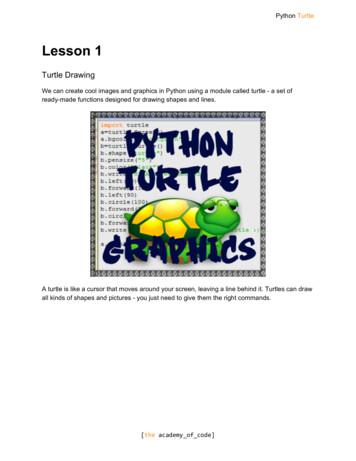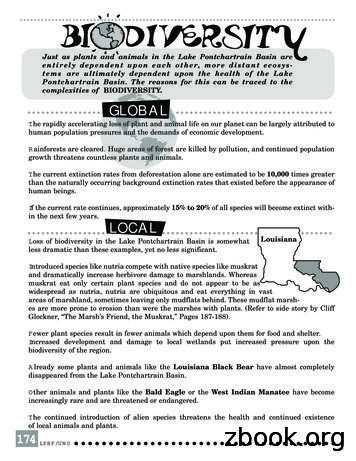Tucker Turtle Takes Time To Tuck And Think Scripted Story Tips
Tucker Turtle Takes Time to Tuck and ThinkScripted Story TipsFor tips and guidelines about “Scripted Stories”, please begin by reading “Scripted Stories forSocial Situations Tips” located in the Scripted Stories folder on your CD.This story is intended to be used in conjunction with the “Turtle Technique” (see file on CD).For additional guidance on how to help children with anger control, please read the articleprovided on your CD called “Helping Young Children Control Their Anger and HandleDisappointment”.Please note that you can use real photographs with the line drawings for children that needthis level of support (see Visual Strategies Folder 5 on CD). For instance, next to the linedrawings, you can glue or Velcro a photograph of a child making an angry face, a child who isupset, children who are happy, etc.Assembly Directions:After printing on cardstock paper (or printer paper glued to manila file folder for increaseddurability), bind the edge to form a book. If the book will be handled by the child, it might behelpful to laminate the pages prior to binding to increase durability. See next page(s) for“printing directions”.Lentini, R., Vaughn, B. J., & Fox, L. (2005). Teaching Tools for Young Childrenwith Challenging Behavior. Tampa, Florida: University of South Florida,Early Intervention Positive Behavior Support.
PRINT DIRECTIONS FOR FULL SIZE BOOKStep 1:Click on File & select PrintStep 2:Select slides to print storyType 4-19Step 4:Type # of copiesStep 3:Select “slides”Step 5:Click OKLentini, R., Vaughn, B. J., & Fox, L. (2005). Teaching Tools for Young Childrenwith Challenging Behavior. Tampa, Florida: University of South Florida,Early Intervention Positive Behavior Support.
PRINT DIRECTIONS FOR SMALL SIZE BOOKStep 1:Click on File & select PrintStep 2:Select slides to print storyType 4-19Step 5:Type # of copiesStep 4:Select “2” slides per pageStep 3:Change slides to“handouts”Step 6:Click OKLentini, R., Vaughn, B. J., & Fox, L. (2005). Teaching Tools for Young Childrenwith Challenging Behavior. Tampa, Florida: University of South Florida,Early Intervention Positive Behavior Support.
Tucker TurtleTakes Timeto Tuck andThinkA scripted story to assist with teachingthe “Turtle Technique”By Rochelle LentiniMarch 2005Lentini, R., Vaughn, B.J., & Fox, L. (2005). Teaching Tools for Young Children with Challenging Behavior. University of South Florida.Created using pictures from Microsoft Clipart and Webster-Stratton, C. (1991). The teachers and children videotape series: Dina dinosaur school. Seattle, WA: The Incredible Years.
Tucker Turtle is a terrific turtle. He likes to playwith his friends at Wet Lake School.
But sometimes things happen that can makeTucker really mad.
When Tucker got mad, he used to hit, kick, or yellat his friends. His friends would get mad or upsetwhen he hit, kicked, or yelled at them.
Tucker now knows a new way to “think like a turtle”when he gets mad.Step 1
He can stop and keep his hands, body, and yellingto himself!Step 2
He can tuck inside his shell and take 3 deepbreaths to calm down.Step 3
Tucker can then think of a solution or a way tomake it better.Step 4
Tucker’s friends are happy when he plays nicelyand keeps his body to himself. Friends also like itwhen Tucker uses nice words or has a teacherhelp him when he is upset.
The End!
Teacher Tips on the Turtle Technique Model remaining calm Teach the child the steps of how to control feelings andcalm down (“think like a turtle”)– Step 1: Recognize your feeling(s)– Step 2: Think “stop”– Step 3: Tuck inside your “shell” and take 3deep breaths– Step 4: Come out when calm and think of a“solution” Practice steps frequently (see cue cards on next 4 pages) Prepare for and help the child handle possibledisappointment or change and “to think of a solution” (seelist on last page) Recognize and comment when the child stays calm Involve families: teach the “Turtle Technique”Webster-Stratton, C. (1991). The teachers and children videotape series: Dina dinosaur school. Seattle, WA: The Incredible Years.
Step 1
Step 2
Step 3
Step 4
Help the Child Think of aPossible Solution: Get a teacher Ask nicely Ignore Play Say, “Please stop.” Say, “Please.” Share Trade a toy/item Wait and take turns Etc.Lentini, R., Vaughn, B. J., & Fox, L. (2005). Teaching Tools for Young Childrenwith Challenging Behavior. Tampa, Florida: University of South Florida,Early Intervention Positive Behavior Support.
Tucker Turtle Takes Time to Tuck and Think Scripted Story Tips For tips and guidelines about “Scripted Stories”, please begin by reading “Scripted Stories for Social Situations Tips” located in the Scripted Stories folder on your CD. This story is intended to be used in conjunction with the “Turtle Technique” (see file on CD).File Size: 492KBPage Count: 19
TUCKER THE TURTLE: TECHNIQUE TO SELF REGULATE During circle time, introduce Tucker the Turtle. Use a stuffed turtle puppet as you begin to read the scripted story Tucker Turtle Takes Time to Tuck and Think. Have children make their own turtle puppet, practice the 4 steps of th
Make a turtle and load it into a variable. tina turtle.Turtle() We have named the turtle Tina, however, you can give the turtle any name you want. Set the colour that the turtle will use to draw the shape. tina.color( ' blue' ) Set the style of the turtle with a function called shape. tina.shape( ' turtle' )
turtle graphics is fun and it enables you to use Python to be visually creative! 13.2 Turtle Basics Among other things, the methods in the turtle module allow us to draw images. The idea behind the turtle part of “turtle graphics” is based on a metaphor. Imagine you have a turtle on a canvas that is holding a pen.
Tucker Turtle Puzzle! After reading the scripted Tucker Turtle Story, the attached puzzle can be used as a follow-up at home or in the classroom. Have children glue the puzzle on card stock and then cut out the puzzle on the black lines. (If using the black-lined Tucker Turtle, have children color it before
ucker Turtle is a terri f ic turtle. He likes to play with his friends at Sunny Stream School. Hi! I’m Tucker. ABC Sunny Stream School Tips on the T u r t l e T e c h n i q u e Model remaining calm. Teach the children the steps of how to control feelings and calm down (“think like a turtle”). Step 1: Recognize your feelings .
by a turtle/deposited in a nest at one time. Crawl: Tracks and other signs left on a beach by a sea turtle. Egg cavity (chamber): The hole dug by the rear flippers of a nesting turtle into which the turtle lays her eggs. False crawl: The track left by a sea turtle that has ascended a beach but returned to the sea without laying eggs.
REPTILES Gopher Tortoise Kemp’s Ridley Sea Turtle Green Sea Turtle Hawksbill Sea Turtle Leatherback Sea Turtle Loggerhead Sea Turtle Ringed Map Turtle Louisiana Quillwort 177 LPBF/UNO INVERTEBRATES Inflated Heelsplitter Mussel
language, font, or codepage, or otherwise configure or adjust the printer. Many leading IT systems and enterprise software applications are now users of the Unicode Standard. Organizations can print international language labels directly from their applications by networking a Unicode -enabled printer to these systems.























